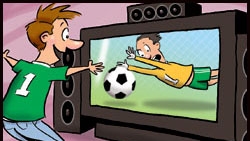Soccer kicks off HD in Europe

Coming back from IBC, I felt very fit. I found out why after talking to the folks at Omneon. The company had issued pedometers to the press, and it turns out that we were walking about 13km a day around the show halls. Apart from my good health, the industry also had a healthy feel.
The start of HD transmissions across Europe has created a renewed interest in upgrading old plans. First off the blocks has been the construction of new OB vehicles to cover the Torino Winter Olympics 2006 and the soccer World Cup in Germany next May. Sport is a great way to launch a service; history has shown that guys are prepared to spend money to watch their favorite game.
Many broadcasters I spoke to at the show say they have now stopped buying SD-only equipment. It must be HD-capable, even if they are not making HD programs right now. With program commissioners asking for HD in increasing numbers, no one wants to be left behind. That said, there is no rush to shoot in HD when buyers have not asked for that format.
There is a general view that in Europe, the public demand for HD receivers is going to be slow to build. Unlike the USA, where large-screen sizes are commonplace, Europeans tend to have smaller screens, where HD offers no real advantage. Another factor is that there is no reserved space in digital multiplexes for HD, so an operator would be faced with the choice of one HD channel or three or four SD channels — a difficult business decision.
It has been thought that the big driver for consumer purchases would be high-definition DVDs. Once the public sees the latest movies on a big screen at home, then it will expect the same picture quality from broadcasters. In the lead up to the roll-out of high-definition DVDs, we all looked back at the experience of VHS/Betamax and SACD/DVD-A. We saw that the public will not accept two formats. Either one format wins out, or the entire medium is shunned. So what has happened? We have two incompatible HD formats battling for supremacy: HD DVD and Blu-ray. Are there no lessons from history? Studios seem equally split as to which format they will support, but how will retailers and consumers take to two formats?
So perhaps the high-definition DVD will not be a Trojan horse to bring HD into the home. We fall back on that reliable crowd-puller — live broadcast sport. From the engineering standpoint, coverage of sport stimulates innovation by the equipment suppliers. The big guys supply high-performance lenses and cameras, slow-motion recorders and all the graphics equipment. The little guys develop the widgets to the get coverage from all angles of play.
Viewing at home, the excitement of the crowd is missing, but television makes up by delivering a different experience. The move to HD offers new opportunities to enhance the coverage of sport as compelling entertainment, to offer a viewpoint that the spectator in the stadium just cannot see. It looks very much as if it will be sport rather than optical disks that kicks off the move to HD.
The professional video industry's #1 source for news, trends and product and tech information. Sign up below.
Send comments to: • editor@broadcastengineeringworld.com • www.broadcastengineering.com
